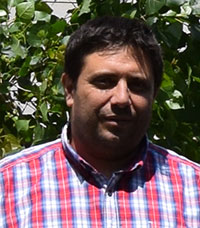 Michele Mazza. Dipartimento di Scienze della Terra "A. Desio", Università degli Studi di Milano, Via Mangiagalli 34, 20133, Milano (Italy); michele.mazza@unimi.it; mazza_michele@yahoo.it
Michele Mazza. Dipartimento di Scienze della Terra "A. Desio", Università degli Studi di Milano, Via Mangiagalli 34, 20133, Milano (Italy); michele.mazza@unimi.it; mazza_michele@yahoo.it
Michele Mazza (Piacenza, 1978), took his Master Degree in Geology and Palaeontology in 2005 at the University of Milan and he obtained his PhD degree in Earth Sciences in 2010 at the same University. He worked as a PostDoc researcher in biostratigraphy and palaeontology for four years (from 2011 to 2015) at the Department of Earth Sciences "A. Desio" (University of Milan).
He is a conodont specialist and his main research interests are Middle and Late Triassic condont biostratigraphy, systematic, paleoecology (stable isotopes of Oxygen, Carbon and Strontium), phylogenesis and evolution. He is member of the International Working Groups for the definition of the GSSP of the Norian Stage from 2006 (candidate section Pizzo Mondello, Western Sicily, Italy) and of the Raethian Stage from 2016 (candidate section Pignola-Abriola, Southern Apennines, Italy).
In the last three years he focused his research activity on the correlation of the Late Triassic conodont faunas of the Tethys to the North American faunas and on the study of the ontogenetic processes of conodonts reconstructing traditional growth series and using innovative x-ray synchrotron microscopy. From 2012 he is Technical Editor of the ISI journal "Bollettino della Società Paleontologica Italiana".

 Carlos Martínez-Pérez. Departamento de Geología, Universidad de Valencia, Avda. Dr. Moliner, 50, 46100 Burjassot, Valencia (Spain); carlos.martinez-perez@uv.es; School of Earth Sciences, University of Bristol, Wills Memorial Building, Queen’s Road, Bristol BS8 1RJ, UK; carlos.martinez-perez@uv.es
Carlos Martínez-Pérez. Departamento de Geología, Universidad de Valencia, Avda. Dr. Moliner, 50, 46100 Burjassot, Valencia (Spain); carlos.martinez-perez@uv.es; School of Earth Sciences, University of Bristol, Wills Memorial Building, Queen’s Road, Bristol BS8 1RJ, UK; carlos.martinez-perez@uv.es
Carlos Martinez-Perez (Valencia, 1978) obtained his PhD in Biology at the University of Valencia (Spain) in 2010. From 2011 to 2014 he was a Postdoctoral fellow at the University of Bristol working on condont palaeobiology, and since 2015 he is Assistant Professor at the University of Valencia. His main research interests are in the area of early vertebrate palaeobiology, using state of the art computational techniques, including tomographic, to shed light into the function and evolution of the vertebrate skeleton.

